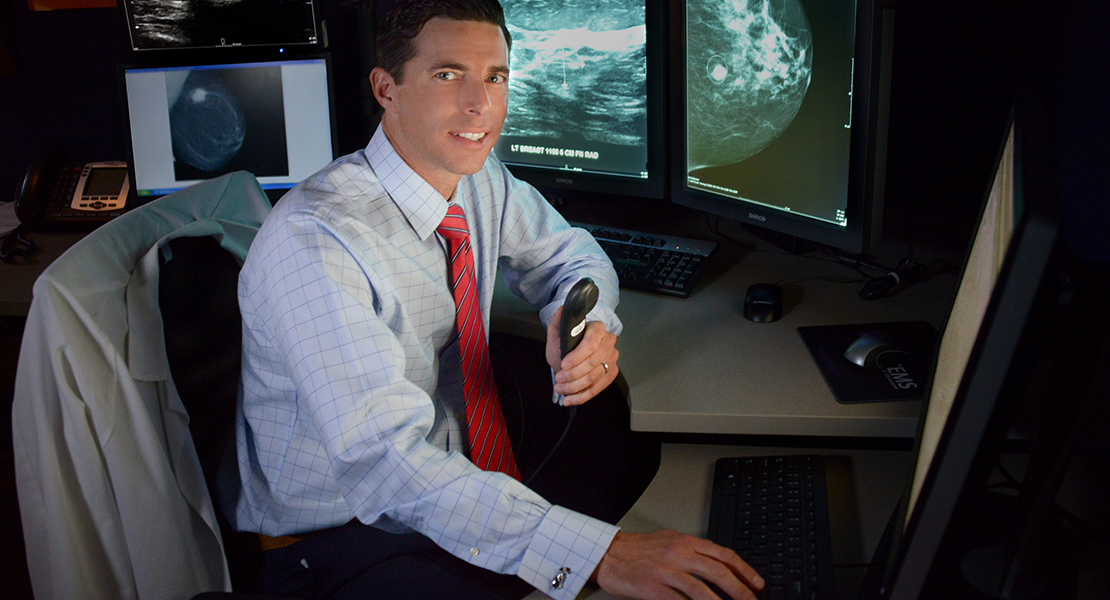Breast Cancer Prevention is Better Than Ever
One in eight women in the United States will be diagnosed with breast cancer in their lifetime, making it the most commonly diagnosed cancer in women—a pretty sobering statistic. The good news: Breast imaging has come a long way since the late 1960s, when modern mammography methods were developed.
“Women can control what they see and hear during a mammogram”
By 1976, mammograms were officially recommended by the American Cancer Society (ACS) for the detection of breast cancer. Today, physicians continue to use mammography and a number of state-of-the-art breast imaging technologies to help detect breast cancer at its earliest, most treatable stage, including breast MRI, automated breast ultrasound, and low-dose 3D mammography (aka digital breast tomosynthesis). These advanced tools are reassuring for many women and may even save your life.
The ACS says that women should have their first screening mammogram by age 45, and that they should have the choice to start screening as early as age 40.
I was in my early 40s when I had my first mammogram at the Women’s Imaging Center at St. Luke’s North in Bethlehem. I was nervous—a very good friend of mine had recently fought a battle with breast cancer, and the thought of it loomed large in my mind—but I was pleased at how quick, efficient, and painless the process was. I was also extremely relieved to learn I was cancer-free. Having my first mammogram go well put me at ease.
The Most Effective Mammogram Yet
Today, mammograms can be better and safer than ever—especially if you go to a facility with modern equipment and experts specifically trained in breast health. St. Luke’s offers screening mammograms at Women’s Breast Imaging Centers throughout the Greater Lehigh Valley and offers the lowest dose 3D mammography in the region.
“For years, the trade-off of 3D mammograms was the increased radiation dosage,” says Joseph Russo, MD, section chief of Women’s Imaging at St. Luke’s University Health Network. “But that’s not the case anymore.”
St. Luke’s is in the enviable position of having waited for the latest generation of 3D equipment, which delivers the same low-dose radiation as the standard digital mammography equipment that’s been in place for decades.
“In other words,” says Dr. Russo, “we are able to detect more cancer without putting patients’ health at an increased risk.”
A More Relaxing Experience
Even thinking about having a mammogram can stress out some women. To ease this anxiety,
St. Luke’s offers mammograms in a room known as a Sensory Suite, which features a flat screen TV that display relaxing natural scenes and sounds in a variety of themes—seaside, garden, or waterfall.
“Women can control what they see and hear during a mammogram, which is tremendous,” says Dr. Russo. “Moreover, it’s a symbolic expression of how every woman is different.”
To further enhance the patient experience,
St. Luke’s became first in the region to offer the Dueta remote, a device that offers patient-controlled compression during a mammogram with the help of a technologist. This technology is available at the new Stroudsburg location.
Personalized Options
for High-Risk Women
If you’re a woman at high risk of breast cancer, or if you find a lump or other concerning symptom, St. Luke’s creates a screening approach based on your personal risk factors. This results in earlier detection of breast cancer and can decrease the number of return visits and unpleasant biopsies.
“This means that a woman’s personal risk of breast cancer and her specific breast density are factored into determining the best screening regimen for her,” says Dr. Russo. “If a woman has dense breasts, this may result in a combination of screening exams.”
For women who need more evaluation or diagnostic mammograms, higher level breast imaging is available at St. Luke’s Regional Breast Centers in Center Valley and Stroudsburg, and through St. Luke’s Regional Breast Services in Phillipsburg, NJ.
To further enhance the experience, St. Luke’s Regional Breast Center’s certified breast health nurse navigators provide education and support every step of the way, guiding women through their diagnostic exams, breast biopsies, and diagnoses with care and compassion. Because no woman should ever have to face the fear and confusion of breast cancer alone.
Check Yourself!
In addition to mammograms, experts recommend that women perform regular self-breast exams. If you find a lump or dimple, or notice nipple discharge, it’s important to see your doctor ASAP. For instructions on how
to perform a self-exam, visit www.nationalbreastcancer.org/breast-self-exam.





















